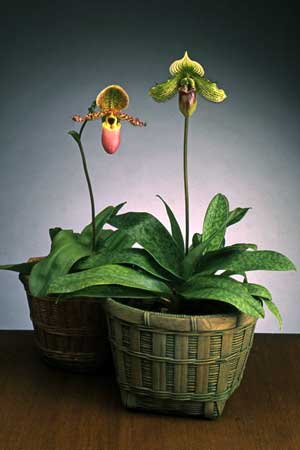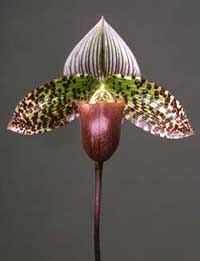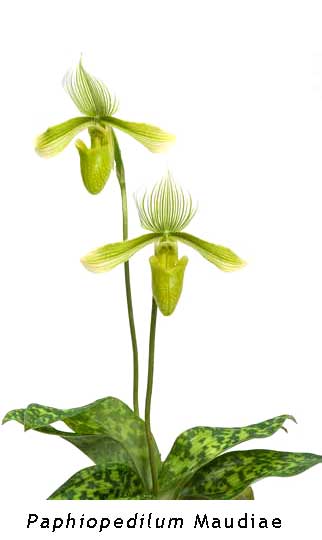|
Welcome to the AOS Beginner's Newsletter. We will be sending you monthly tips on how to grow orchids and help you get them to bloom again. In addition to the information presented here, we invite you to visit the AOS website at www.aos.org and check out the information found under ORCHID INFORMATION > ORCHID BASICS.
Lady Slippers
Basic Culture of Paphiopedilums
 In simple terms, all orchids have lips instead of a sixth petal. Some lips are big and colorful, some are miniscule and hidden. The lips of paphiopedilums are pouches which make them easy to recognize. Because the pouches in some paphiopedilums resemble footwear, they are informally called "lady slippers." Other orchids have pouches and some, closely related to paphiopedilums, are also called "slippers." But the commonly available slipper orchids are paphiopedilums. In simple terms, all orchids have lips instead of a sixth petal. Some lips are big and colorful, some are miniscule and hidden. The lips of paphiopedilums are pouches which make them easy to recognize. Because the pouches in some paphiopedilums resemble footwear, they are informally called "lady slippers." Other orchids have pouches and some, closely related to paphiopedilums, are also called "slippers." But the commonly available slipper orchids are paphiopedilums.
Although they all have a family-resemblance because they have pouches, they are diverse in size, color, and form. They come with spots and splashes, stripes and warts. They can be very large plants or very small, even dwarf. The flowers can be enormous, with long petals or they can be miniatures. Fortunately, most are moderate both in plant and flower size. Large or small, they can be white to very dark maroon, almost black. The white ones can have dark spots, which at times are so thick they hide the flower's whiteness. They can be very red and very green. They can have hairs and warts in the most interesting places. And the vast majority is very easy to grow. There are exceptions, and as you become more experienced you may want to try your hand at some of the more demanding paphiopedilums.
By easy, I mean they are really good as house plants. They like the same temperature and light that people prefer. Some will like a little more humidity than your house provides, especially in the winter when heating dries the air, but that can be provided by putting the plant on a shallow tray of pebbles with water.
Basic Care
Paphiopedilums thrive in conditions found in the average home.
Temperature
Almost all commonly available paphiopedilums will do well in intermediate temperatures — that is above 60ºF at night and below 80ºF during the day. Paphiopedilums with mottled leaves will like it a little more on the warm side.
Light
With the exception of a few large flowering types (which are usually too big for home growing), almost all paphiopedilums grow well in the intermediate light found near an east facing window window (west or south windows can also be used if shaded with a sheer curtain). If the plant does not bloom, put it nearer to the window. In no case, however, put it in direct sunlight.
Water
Paphiopedilums do not store water. Therefore, they need to stay slightly moist, never completely drying out. They will not do well if they are kept constantly soggy. Stick your finger in the pot, if you do not feel moisture on your finger tips, consider watering. Water less when temperatures are cooler and light is less intense.
Humidity
Orchids, as a group, like humidity. Your paphiopedilums will be happy at about 50% relatively humidity. Most will tolerate periods of rather dry air but, to grow well, monitor the humidity. If the humidity goes too low, put your plants on trays of moist gravel. If it goes high, increase the air movement. Air movement is good in general for paphiopedilums, as it is for all orchids, but only if the temperature is right — keep your plants and yourself out of cold drafts.
Fertilizer
Give your plants liquid plant foods, approximately 20-20-20 in formulation will be fine. The amounts of fertilizer needed by orchids is surprisingly low — use less than half of the recommended dose and fertilize with every other watering.
Repotting
Paphiopedilums like to be repotted every year. You can make up a mix for your plants with fine bark, perlite, fine lava rock, oyster shell, and other products. You can also just put them in fine bark — developing a more complex mix when you have more plants and experience. Just don't put them in dirt — the mud will suffocate your plant. When repotting, take the plant out of the old pot and put it in a slightly larger pot (if it has grown since you last repotted it). Gently remove old bark but do not be overly vigorous — a few sticking pieces of bark will do no harm. The plant should stand firmly in the pot after you have pushed the mix down around it.
 |
 |
 |
| Paph. British Concorde 'Crystelle' AM/AOS |
Paph. St. Swithin 'Nike' CCM/AOS |
Paph. Macabre 'Miami' AM/AOS |
Buying your first Paphiopedilum

Paphiopedilums are available through retail outlets, like big-box stores. Although the salespeople in such stores are not likely to be able to help you, the store will be selling orchids which have a real chance of surviving the inhospitable environment of a store. Just be sure the plant you buy is healthy looking with no damaged leaves or crumpled flowers. A better place for your first purchase would be a local vendor specializing in orchids. The vendor will be able to guide you toward a good first plant. If you attend an orchid society meeting near you, you will almost be guaranteed to see lots of paphiopedilums, along with many other interesting orchids. Many local societies have vendors at their meetings.
Buy your first orchids in bloom. This guarantees that the plant is vigorous and will give you instant enjoyment. Buy a paphiopedilum that you like: you will likely be enjoying it for a relatively long time — both now and when you rebloom it. Success with my first paphiopedilum helped convince me that I could grow orchids. The first paphiopedilum I owned was a "Maudiae-type," which means it had
Paphiopedilum callosum in its background. Maudiae-types are classic and regularly sold at shows or local society meetings. However, any paphiopedilum which you find interesting will do fine. Just ask your vendor for tips on growing — if it is one of the rare difficult ones, the seller should be able to warn you.
Greg Truex
AOS Education Committee
Orchid Photo of the Week
Do your friends and family tell you how beautiful your photos of your orchids are? Do you think they deserve recognition? Do you have what it takes to go up against the very best? Then maybe it's time for you to submit something to "Photo of the Week" - give it your best shot!
Each week one image from the Flickr® group, Orchid Photo of the Week, will be featured on the website homepage of the AOS. The very best will be selected for a feature in Orchids magazine.
Be sure to read the complete instructions here. And remember, we are looking for the cream of the crop of orchid photography. So fire up your digital camera and get shooting!
Join the AOS today and get twelve great issues of our magazine, packed with breathtaking color photography and enlightening and informative articles written by orchid experts from around the world. PLUS you get our Membership Newsletter and members-only website content like Orchids A to Z and select magazine article reprints.
If you love orchids, you can't
not be a member!
ORCHIDS magazine upcoming features...
 THIS MONTH
THIS MONTH
º Blue Cattleyas
º Phragmipedium richteri and Its Hybrids
º Collector's Item: Pleurothallis pectinata
left: Tolumnia bahamense photographed in a State Park, Martin Co., Florida
OCTOBER
º How to Grow Nobile Dendrobiums
º What's in a Name: Guarianthe patinii
º Phragmipedium section Phragmipedium
send comments to - newsflash@aos.org
| 
